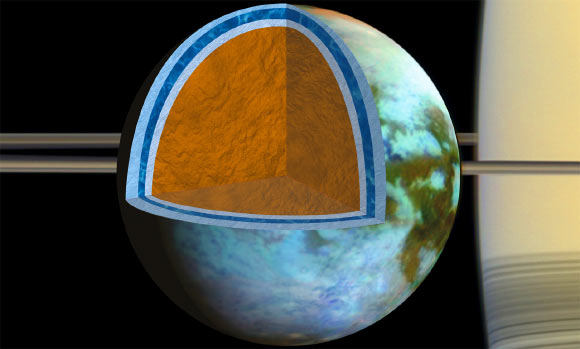A detailed analysis of gravity and topography data from Titan, the largest moon of Saturn, provides strong evidence that the ocean inside the moon might be as salty as Dead Sea.

Titan’s ice shell, which overlies a very salty ocean, varies in thickness around the moon, suggesting the crust is in the process of becoming rigid. Image credit: NASA / JPL-Caltech / SSI / University of Arizona / G. Mitri / University of Nantes.
“This is an extremely salty ocean by Earth standards. Knowing this may change the way we view this ocean as a possible abode for present-day life, but conditions might have been very different there in the past,” said Dr Giuseppe Mitri of the University of Nantes in France, who is the lead author of a paper reporting the findings in the journal Icarus.
“Titan continues to prove itself as an endlessly fascinating world, and with our long-lived Cassini spacecraft, we’re unlocking new mysteries as fast as we solve old ones,” added Dr Linda Spilker of NASA’s Jet Propulsion Laboratory in Pasadena, who was not involved in the study.
Dr Mitri and his colleagues found that a relatively high density was required for Titan’s subsurface ocean in order to explain the gravity data.
This indicates the ocean is probably an extremely salty brine of water mixed with dissolved salts likely composed of sulfur, sodium and potassium. The density indicated for this brine would give the ocean a salt content roughly equal to the saltiest bodies of water on Earth.
The findings support the idea that the Titan’s icy shell is rigid and in the process of freezing solid.
The data, collected by Cassini spacecraft, also touch on a major mystery – the presence of methane in Titan’s atmosphere.
Planetary researchers have long known that Titan’s atmosphere contains methane, ethane, acetylene and many other hydrocarbon compounds.
But sunlight irreversibly destroys methane after tens of millions of years, so something has replenished methane in Titan’s thick air during the moon’s 4.5 billion-year history.
The study indicates that whatever process is responsible, the restoration of Titan’s methane is localized and intermittent.
“Our work suggests looking for signs of methane outgassing will be difficult with Cassini, and may require a future mission that can find localized methane sources. As on Mars, this is a challenging task,” said co-author Dr Jonathan Lunine of Cornell University in Ithaca, New York.
_____
Giuseppe Mitri et al. 2014. Shape, topography, gravity anomalies and tidal deformation of Titan. Icarus, vol. 236, pp. 169–177; doi: 10.1016/j.icarus.2014.03.018







